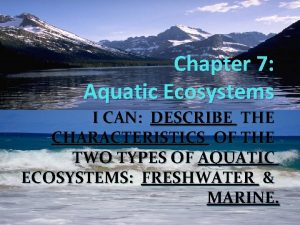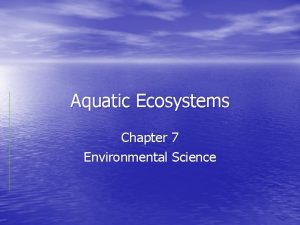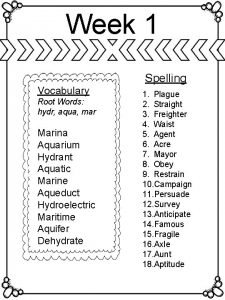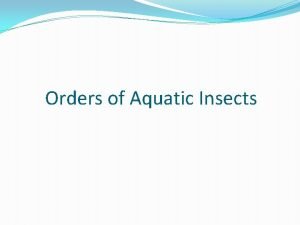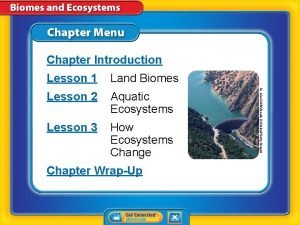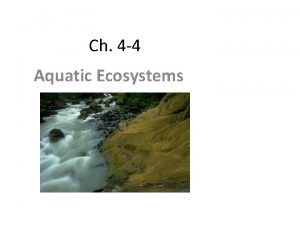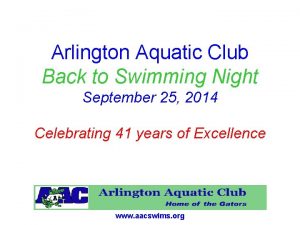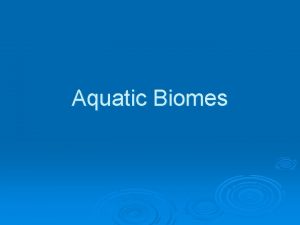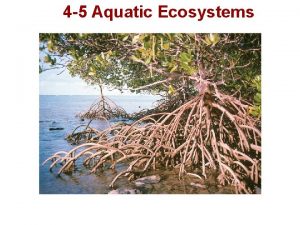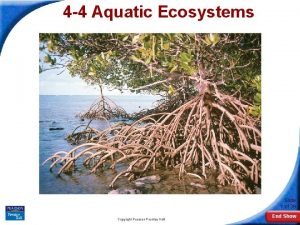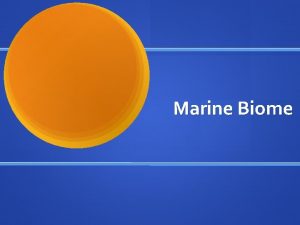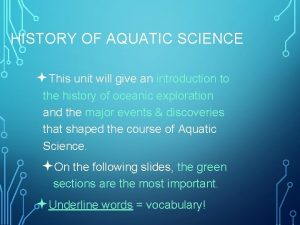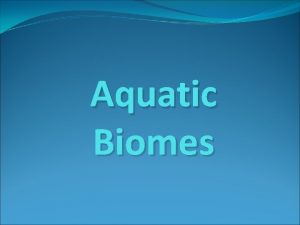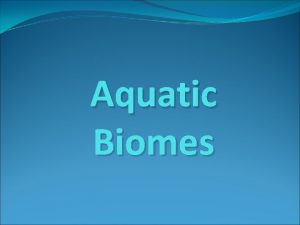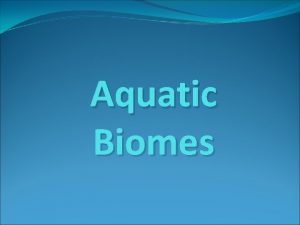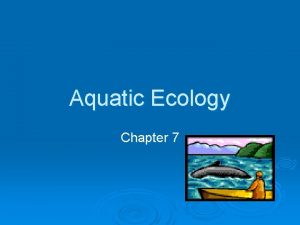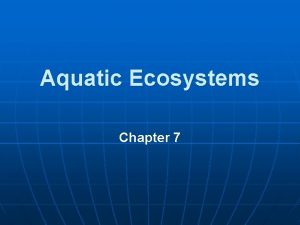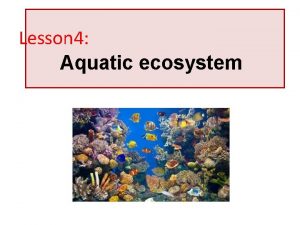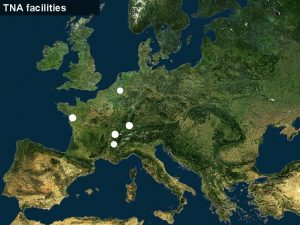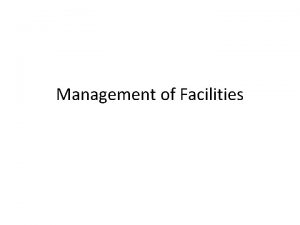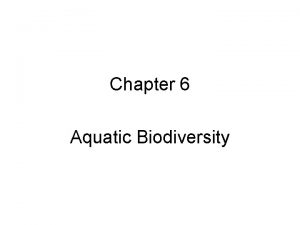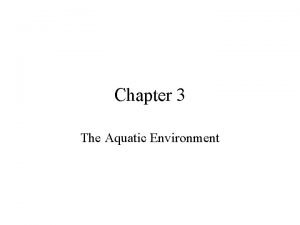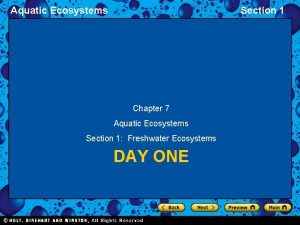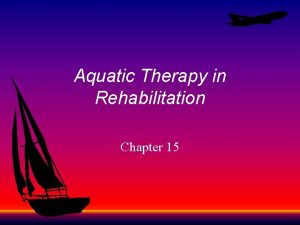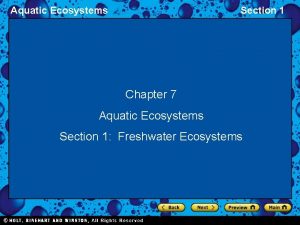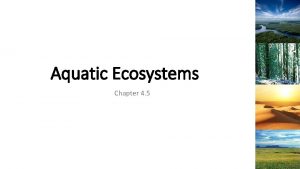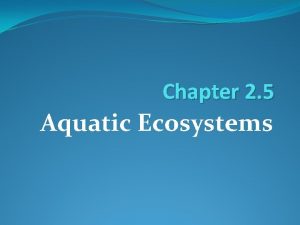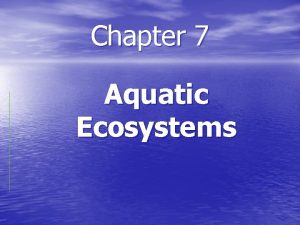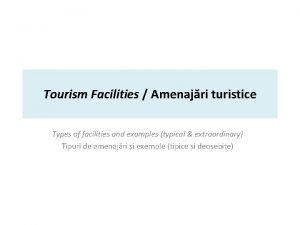chapter 17 Aquatic Facilities Types of Aquatic Facilities































- Slides: 31

chapter 17 Aquatic Facilities

Types of Aquatic Facilities • Aquatic facilities can be found in indoor and outdoor settings and may be natural or manmade. • Typically, aquatic facilities fall into one of three categories: – Waterfronts – Pools – Water parks



Waterfronts • A waterfront is an outdoor aquatic facility located at a lake, beach, river, or quarry. • The aquatic space includes all open water; that is, the facility is not contained in a closed environment. • Waterfront facilities are commonly used for swimming, boating, and fishing.

Pools • Pools are the most common and basic aquatic facility. • Pools may include a diving board or slide, but for the most part, they offer few amenities. • The traditional pool may include lap swimming areas and a diving well, an area of deep water suitable for diving. • Pools can be located indoors or outdoors and are frequently found in recreation centers, health clubs, country clubs, and hotels.

Water Parks • Water parks are becoming more widespread across the United States every year. • Water parks incorporate different water features designed for maximum entertainment. • Features include water slides, wave attractions, spray features, slow-moving water attractions (for example, a lazy river), toddler play areas, and shallow entries. • Similar to traditional pools, water parks can be indoor or outdoor facilities.

Aquatic Facility Construction • Water parks and pools are man-made aquatic facilities. • Basic construction is usually a concrete basin with a few options for liners. • Sometimes tile is installed on the pool basin and deck. • Both concrete and tile can become a slippery surface hazard. • To combat this, tiles should be one square inch (2. 5 square centimeters) and all decks should be slightly sloped toward a drain to prevent standing water.

Aquatic Facility Accessibility • Accessibility enables all participants to use facilities regardless of disabilities. • The ADA outlines accessibility requirements that should be followed for aquatic areas. • There a few ways to make a pool or water park accessible. – Moveable ramps and stairs – Chair lifts – Moveable floors


Aquatic Facility Operations • Aquatic facilities require a number of key management functions to efficiently operate. • The facility must be adequately staffed, safe, and well maintained. • In addition, it must have proper mechanical systems and quality aquatic equipment.

Staffing • Staffing is the one of the most important concerns that facility managers will encounter when managing an aquatic center. • The most important consideration when hiring staff is finding properly trained and certified employees. • Certification must be obtained before employment occurs. • Aquatic staff may include lifeguards, instructors, and additional staff.


Fee Collection • Aquatic facilities are revenue-generating facilities. • Revenue is typically generated through fee collection where users pay a fee before permitting access the aquatic area. • Access control by staff persons and equipment, including a cash register, credit card machine, or computer are utilized to assist with fee collection.


Aquatic Facility Safety • Safety is a primary concern in aquatic facility management. • When working around a water environment, each decision regarding safety is one of life and death. • Safety has many components, including standards, codes, and safety training for all staff.


Emergency Management • The key to effective emergency management is a solid emergency action plan. • This plan allows staff to assist participants in emergencies in the best possible way. • These plans can encompass near-drowning experiences, spinal injuries, and non-lifethreatening emergencies.


Preventive Supervision • Proper supervision should be part of any plan. • Lifeguards practice supervision every time they sit down in their chair. • By taking steps to ensure that participants are following the rules, lifeguards practice preventive supervision.

Maintenance • Maintenance and hygiene are essential to maintaining safety at an aquatic facility. • A critical aspect when dealing with minor repairs is addressing them as quickly as possible, because the costs can be greater if they turn into major problems later.

Hygiene • Locker room sanitation must be done every day. • Sanitation includes scrubbing toilets, cleaning sinks, scrubbing floors, and hosing showers and other surfaces. • Deck sanitation should also be done every day. • Both before the facility opens and after it closes, the deck should be sanitized with a water and bleach mixture.

Mechanical Systems • The heart of any aquatic facility is the mechanical system that filters and sanitizes the water. • The first consideration in an aquatic mechanical system is the pump. • This piece of machinery circulates the water throughout the aquatic venue. • Pumps can be placed before or after the filter, which is the next key component of a mechanical system.

Sanitation System • The last main part of a mechanical system is the sanitation system. • The two most recognized chemicals used in aquatic sanitation are chlorine and bromine. • Chlorine is the most widely used sanitation chemical and can come in three forms: – Gas – Liquid – Tablet

Mechanical System Maintenance • To ensure that the aquatic mechanical systems are running efficiently, routine maintenance should be performed on the system. • Backwashing the pump and filtration system is a process that should be done every week. (continued)

Mechanical System Maintenance (continued) • Sanitation systems also require basic maintenance. • They must be cleaned and refilled regularly, according to the manufacturer’s maintenance guidelines. • Failure to clean a system can lead to buildup of the sanitizer and hinder the performance of a system. (continued)

Mechanical System Maintenance (continued) • Seasonal pools have the added burden of winterizing or closing the facility for the offseason. • This can include draining the pool, cleaning and dismantling the sanitation system, cleaning the pump, putting away all moveable pool equipment, and locking down the facility.

Aquatic Facility Equipment • There are many types of equipment that allow recreation facility managers to provide almost unlimited types of programming. • This equipment includes: – – Rescue and safety equipment Instructional and fitness equipment Swimming and diving equipment General aquatic equipment


Aquatic Facility Product Delivery Areas • There a number of production delivery areas within an aquatics facility. • Restrooms are ancillary production delivery areas at aquatic facilities that support the core product and are often included in locker rooms. • Retail outlets are core product extensions where users may purchase merchandise or equipment as a part of their aquatic leisure experience. • Production delivery areas that focus on the core product include areas for informal swim, instructional swim, fitness programming, special events, intramurals, clubs, and athletic teams.

External Support • Certain services are vital to an aquatic facility, but facility employees may not be able to provide them. • External personnel such as emergency medical personnel; police, security, and fire; food services; computer and information technology; and maintenance services help to fill in where needed.
 Marine ecosystem webquest
Marine ecosystem webquest Bioma air laut
Bioma air laut Chapter 3 section 3 aquatic ecosystems
Chapter 3 section 3 aquatic ecosystems Chapter 6 biomes and aquatic ecosystems
Chapter 6 biomes and aquatic ecosystems Why biomes are important
Why biomes are important Chapter 3 lesson 3 biomes and aquatic ecosystems
Chapter 3 lesson 3 biomes and aquatic ecosystems Limestone ridges built by tiny animals
Limestone ridges built by tiny animals Chapter 7 aquatic ecosystems test answers
Chapter 7 aquatic ecosystems test answers Fencid
Fencid Lesson outline lesson 2 aquatic ecosystems answer key
Lesson outline lesson 2 aquatic ecosystems answer key Structure of ecosystem
Structure of ecosystem Otters are semi aquatic
Otters are semi aquatic Conspicuous
Conspicuous Energy flow
Energy flow What is aquatic science?
What is aquatic science? Detritus food chain
Detritus food chain Ecosystem pyramid
Ecosystem pyramid Connecting the concepts: aquatic biomes
Connecting the concepts: aquatic biomes Aquatic biotechnology
Aquatic biotechnology 4-4 aquatic ecosystems
4-4 aquatic ecosystems Arlington aquatic club
Arlington aquatic club Frog life cycle
Frog life cycle 4-4 aquatic ecosystems
4-4 aquatic ecosystems Ap environmental science aquatic biomes
Ap environmental science aquatic biomes Examples of aquatic biomes
Examples of aquatic biomes Section 4-4 aquatic ecosystems
Section 4-4 aquatic ecosystems 4-4 aquatic ecosystems
4-4 aquatic ecosystems Model aquatic health code
Model aquatic health code Terrestrial food production systems
Terrestrial food production systems Hyrophytes
Hyrophytes Aquatic biomes examples
Aquatic biomes examples History of aquatic science
History of aquatic science
